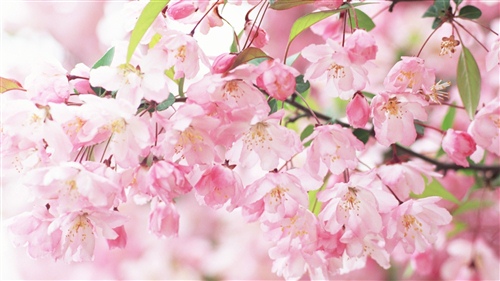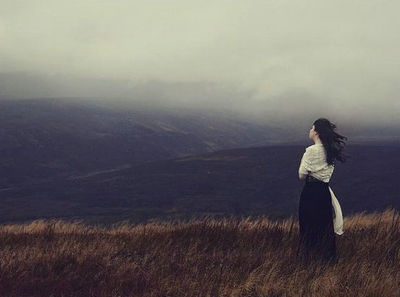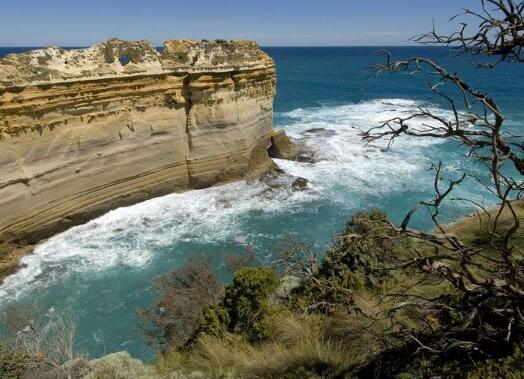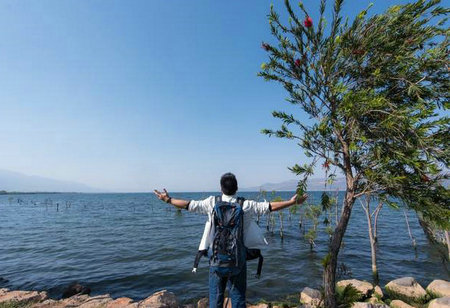
以导游身份写一段南昌至井冈山旅游景点之间的导游词
This mountain has great significance in the annals of modern Chinese history for it was here that important events during the Chinese revolution took place. For those who are interested in the history of the revolution, it is possible to take a tour on . Jinggang that the people who against great odds strugg to establish the Peoples' Republic of China. . Jinggang is famo for the fact that it was here that forces by Zhu De joined those headed by Mao Zedong. Together, the combined forces of the (Chinese Communist Party) marched on to a victory that was to establish the new China under the Chairmanship of Mao Zedong. . Jinggang with its special features is quite different from the other sights, which makes a visit so rewarding.Mt. Jinggang is located on the common boundary of Jiangxi Province and Hunan Province, 352 kilometers (about 219 miles) southwest from the capital city - Nanchang. The mountain areas have a high center that is surrounded by a somewhat lower level and between them they present two obvio steps. At the point that these steps are divided the relative height is 500 meters (about 1640 feet). It was here that the famo Five Sentries (the five Red Army military strongholds built) stood overlooking the difficult terrain. Ather feature of the area is the many well-shaped basins among the ridges. It was these natural indentations that gave the mountain its name of Jing, meaning well and gang, meaning ridge - hence 'Jinggang'. Mt. Jinggang covers a fairly wide area but it is possible to arrange for a to ry you to the various separate sites of interest. These are t far from each other and the cost, which can be negotiated, will be reasonable.The first site of interest is Five-Fingers (Wuzhi) Peak; this is the highest in the Jinggang mountain range. The peak has the appearance of five extended fingers, hence its name. It is t only the highest point but is the largest and considered to be the most beautiful sight on the mountain. The steep peak extends in an imposing way from southeast to northwest. There is no path on which to climb and the unspoi virgin forest on the mountain is almost without any trace of human beings, which means it remains the home of rare animal species including bobtail monkeys, sambars and the yellow-stomached tragopan. Hence it is a secret world even now. Tourists may climb up to the Sightseeing Platform opposite, which is the best view point for seeing its majestic appearance. The huge peaks confront each other on two sides to form a valley. The Mt. Jinggang River twists and turns as it races through this valley. On the mountainside, and visible from a long distance, is a large waterfall that appears like a thin silk veil hanging from the sky. The group of lakes at the foot of Five-Fingers (Wuzhi) Peak is like a bright moon shining upon the boundless sea of clouds. Five-Fingers Peak is now the nature reserve of Jiangxi Province.The next site is the Dragon-Pond (Longtan) waterfalls also referred to as the Five-Dragon-Pond. When you enter this area long before you catch sight of the falls, you will hear the thunder-like roar of the water. Upper most is the Waterfall that drops down to the green and limpid Pond. The second is Lock-Dragon-Waterfall which spews out from the yellow cliff top into the Golden-Lock-Pond. The flow of water is not large but it is famed for what appears like a dragon trapped in it. The next are Pearl Waterfall and Pearl Pond. The waterfall rushes down from a 30 meter (about 99 feet) high cliff and is caught in its path by a large rock that causes the water to break into thousands of pearl-like droplets that glisten in the bright sunshine, hence its name. The forth are the Flying-Phoenix-Waterfall and Flying-Phoenix-Pond. At the bottom are the Maiden-Waterfall and Maiden-Pond. In addition to these spectacular falls there are unique peaks, rocks and an echo cliff to be found in the sightseeing area.Huangyang Jie is one of the five famous sentries. The well-known Defence of Huangyang Jie happened here and Mao Zedong's poem-Xijiang Moon was written to commemorate it. The monument to the Defence of Huangyang Jie is made up of an upright stele and a transverse stele, on which are ved the inscriptions of Mao Zedong and Zhu De. The old residences of the Red Army leaders remain here and many stories about the revolutionary period have come down to us. A trench is also preserved and many tourists put on Red Army attire to be photographed near the trench as a souvenir. The Up-Well (Shangjing) Red Army Mint in Huangyang Jie played a very important role during the Chinese revolution and helped the revolution base to cover the hard period at that time and collected experiences for the other bases. Some of the old equipment is kept there as well as the tools and materials used to make currency. Some Silver dollars (Yinyuan) were unearthed when the mint was restored and in the Currency Museum you can see these coins that were minted by the Red Army.Ciping, the center of the Mt. Jinggang area and red revolution base of China, is the place where many sights can be seen. Ciping is a mountain city and was the location of the highest leading department of the Mt. Jinggang revolutionary base. Now many places of interest in connection with the revolution can be seen here. Among these are the Mt. Jinggang Revolution Museum, the Tower of the Revolutionary Martyrs and military statues. Mt. Jinggang Revolution Museum was established here in 1959. The museum uses modern techniques of sound, light and models to illustrate the important events of the revolution. The main natural beauties in this area are the Southern Mountain Park in south Ciping and the Yicui Garden. On the way to the mountaintop there are five kiosks. There is a pentagon exhibition hall on the mountaintop decorated with the statuary of workers, peasants and soldiers.Pen-Rack-Mountain (Mt. Bijia) is famed for the steep peaks, unique rocks, old pines, sea of clouds, sunrise and the 5 kilometers (about 3.1 miles) patch of rhododendrons-the flower of Mt. Jinggang City. The blooming rhododendrons here can be called a wonder, every March or April thronged people came here to take photos for the beautiful natural sight.Maoping is located in the north foot of Huangyang Jie with many revolutionary sites. Here we have Bajiao Lou (a two-story building), those who are familiar with Chinese history may recall that Mao Zedong lived, worked and finished two splendid revolutionary works here. The first hospital of the base was established in Panlong Shuyuan (a classical academy in ancient China) of Maoping. You can visit the treatment room, medicine room and see some of the equipment used at the time. Another site that provided support to the base is a bedclothes factory which mainly produced the army clothes, hats and bullets bags. Each of these sites made a contribution to the achievements of the Red Army.The famous Monument and Memorial to the Joining of Forces on Mt. Jinggang is situated in the Dragon-city (Longshi) area, southwest of Huangyang Jie. The monument commemorates the achievement of Mao Zedong and Zhu De. The five exhibition rooms present the important event in Chinese history to tourists. The monument is 19.28 meters (about 21.1 yards) high, 5 meters (about 5.5 yards) long and 4 meters (about 4.4 yards) wide which indicates the date of join forces-May 4th, 1928. The two sides of the monument are inlaid with red marble, symbolizing two oriflammes, depicting the successful meeting of the two forces on Mt. Jinggang.Mt. Jinggang has an indispensable place in Chinese revolutionary history and offers a good insight into the history of the Chinese revolution. However, this is not only a Red Army tourist spot but is also an area of natural beauty that offers you plenty of scope for relaxation.
井冈山讲解词有哪些
好了,我们下高速开始上井冈山了,大家都知道井冈山是革命的摇蓝,红色的根据地,是中国第一个农村革命根据地
但现在更是发展成为一个国家5A级旅游风景区
1966年陆定一老先生重上井冈山时写过一首诗,第一句话就说了:井冈山二件宝:历史红,山林好
我们这次上井冈山除了学习井冈山精神,重温当年毛主席在井冈山创建农村根据地的那段光辉岁月外,还可以领略井冈山秀丽的自然风光(讲山林好、这山林好的介绍,大家随便到哪里抄一点介绍井冈山风光的资料就行了,只是要注意如果要推销野味拿回扣的话,就多介绍那些可怜的野生动物吧) 所以说井冈山是一座风景如画的旅游风景区,但大家在领略这美丽风光的时候,是不是也该想想我们今天的幸福生活是多么来之不易啊
毛主席在井冈山创建井冈山革命根据地是多么艰辛,是多少革命先烈士用血肉之躯铺就面成的啊
这些才是大家来井冈山的主要意义吧
(讲井冈山发展历史)井冈山其实原先只是一个不为外界所知的山而已,井冈山发展的历史也比较短
当然通过考古发现,井冈山在西汉开始有人居住,但没有史料记载,到了明代开始有记载,因为在这时发生一件重大的事情,一是明朝朱宁王朱宸濠起兵造反,后来受到王阳明的镇.压,为了逃命就躲到这井冈山深山老林里面来了,成为土籍井冈山人
也就是第一批土匪!二是清末广东福建为躲战乱逃到井冈山,成为客籍井冈山人!(这里插入井冈山的名字的由来)土籍客籍开始为了争夺土地,井冈山进入腥风血雨的年代,辛亥革命后一些地痦流氓也窜入井冈山,加入土或客籍当中,这样打来打去形成后来的袁文才,王佐二大土匪帮,不过这土匪和其它土匪有着本质的区别的,它们只是土客籍集团的力量代表
三是毛主席上山赋予井冈山新含义,因被国民党称为共.匪
所以毛主席曾开玩笑说,井冈山自古以来是匪类聚居之地
当然现在井冈山是革命摇蓝,红色根据地,但毛主席上山也是经过一段曲折的过程的
(讲井冈山历史红)从下面几个方面来讲: 一是毛主席为什么要上井冈山,二是毛主席是如何上井冈山的,三是毛主席上井冈山后做了什么事情,四是井冈山对我们产生什么样的影响,说到毛主席上井冈山,我们还得从27年4月12日开始说起,(毛主席为什么要上井冈山)27年4月12日反革命政变——8月1日南昌起义——8月7日八七会议——9月9日秋收起义(四个团6000来人,攻浏阳取长沙,失败)——9月19文家市集合(确定走农村包围城市道路,打游击战争)——9月22日萍乡芦溪战役(卢德铭牺牲,军心动摇)——9月29日三湾改编(士兵自由可以回家,建士兵委员会,党支部建在连上,把工农革命军第一军第一师整编为第一团)——10月3日古城会议(1927年10月3日,率领工农革命军从三湾来到这里,当天在古城文昌宫召开了前委扩大会议,即“古城会议”。
参加会议的有前委委员,工农革命军营以上干部,党的活动分子以及宁冈县党组织负责人共60余人。
在会上总结了秋收起义的经验教训,阐明了创建农村革命根据地的重要意义。
会议着重讨论和决定了在井冈山建立革命根据地和开展游击战争问题,明确了团结当地农民武装力量和土客籍群众共同建设根据地的方针。
古城会议为建立井冈山革命根据地作了思想上和政策上的准备)(毛主席怎么样上井冈山)经过古城会议后,决定上井冈山,派宛希先,何长工分别去找袁文才,王佐部队,10月6日宁冈大仓村会面(毛主席阐述上井冈山的理由:一是山险有利打游击,二是地理位置可以星星之火可以燎原,三是物产丰富,四是革命基础好,五是看中袁王二兄弟手上的枪
)(在这里也可以讲毛主席初次见贺子珍的情景,这是客人感兴趣的!)——10月24日到大井村,受到王佐部队的热烈欢迎——10月27日到茨坪,(毛主席上井冈山做了什么)为了方便新导游更容易记住井冈山斗争史,我用简单的语言介绍,你们自己补充一点内容就可以了,至于其它还有一些内容:象什么湘赣边界第一次第二次代表大会,什么土地革命啊,你们就可说也可以不说了,免得搞不清头绪.1927年10月27——1928年2月井冈山根据地创建时期一是自已部队休息——二是团结改造袁王的部队,着重说清楚团结改造和整编意义有什么不同——三是毛说打得一拳开,免得百拳开,主动出击——攻打湖南茶陵县,建茶陵县人民政府,红色政权的建立标志井冈山革命根据地正式形成,随便政府主席陈浩叛变,枪毙后改为茶陵县工农兵政府——随便遂川,永新,莲花,宁冈都建工农兵政府,井冈山革命根据地初具规模——东起拿山,西至水口村,南起黄坳村,北至茅坪村,周长500里,俗称“五百里井冈1928年2月——1929年1月井冈山根据地巩固和建设时期南昌起义部队回到湖南湘南暴动——湖南省委派周鲁上山命令毛主席带部队下山与南昌起义会合,攻打长沙——毛下山,工农兵政府被人占领,导致三月失败——到了长沙,由于敌军力量强大,失败,毛提出回井冈山,派何长工去找朱德,朱德派毛泽覃找毛——1928年4月28日朱毛宁冈龙市会师,成产工农革命军第四军,5月才改为中国工农红军第四军——夺回失去的工农兵政府——5月26日毛贺在宁冈象山庵结婚——国民党一看朱毛会师——28年5、6月派二个团第一次会剿(会剿和围剿是有区别的,新导游特别要注意,不要瞎讲啊,会剿是发生在井冈山根据地中,围剿是发生湘赣根据地中,国民党对共产党发生二次进剿,三次会剿,五次围剿),龙源口大捷——7月22日彭德怀滕代远平江起义,又出现湘南革命高潮——湖南省委派杜修经上山命令毛下山去湖南和彭会合,攻打长沙——毛下山,红色政权又被国民党破坏,导致八月失败——由于叛徒告密,国民党知道红四军主力下山——7月8月派四个团第二个会剿,直攻黄洋界,(这里着重讲黄洋界保卫战,讲《西江月。
井冈山》)——毛进攻长沙失败回井冈山,听说井冈山保住了,非常高兴,重新夺回红色政权(也就是工农兵政府)——国民党一看二次进剿都进攻失败,知道攻打五大哨口是件困难的事情,于是强攻不成,心生一计,就是经济封锁,想把红军困死在井冈山——毛为了反经济封锁,做了好多好多的事情,建被服厂,挑粮,建医院,边境圩场,公卖外,联合中农发挥白区商人的优势等等——经济封锁失败,国民党没办法,还是要强攻——28年12月宁冈新城毛彭会师,成立红五军——29年1月,在宁冈茅坪陈开恩的一个牧民的带领下,绕开五大哨口,抄小路进攻井冈山腹部,打小井红军医院——由于寡不敌众,事发突然,被迫下井冈山,去了第二个革命根据地“九陇山革命根据地”——国民党在山上“石头要过刀,茅草要过火,人要换种”——第三次反会剿失败1929年1月——1930年2月坚持井冈山的斗争29年5月,王佐带部队重新夺回井冈山,但面目全非,毛说不要花更多的人力物力去重建井冈山革命根据地,我们只要守住井冈山,主要花力气去山下建立一个更大的湘赣革命根据地,这山上只发生一些小战争——1930年2月24日,袁、王被杀,点击看具体内容,王佐哥哥王云龙叛变革命下山,带国民党上山,井冈山根据地从此失败。
(井冈山产生的影响)星星之火燃遍全国——思想初具雏形——军队和党的建设重要里程碑,确立党领导枪的原则等——形成了著名的井冈山精神.这井冈山的导游词,新导游只要记住我的这根线(提纲),掌握这提纲后再补充内容,因为时间地点人物比较多,新导游都很怕讲井冈山,所以帮你们整理一下
模拟旅游,在下面选一个景点,写一则导游词,向大家进行介绍(100
虽然说导游词旨在用平时的口头语去为游客讲解,但其实它还是参杂一些模式的。
要想写好导游词,起初我们要做好一些前期的准备工作。
首先要确定目标景点,接下来我们可以实际去景点参观一下,或者到网上去搜集一些资料,这一步的工作重点是要将景点的特色,形成背景,以及景点背后的故事传说融会贯通。
准备好以上的材料之后,接下来我们就要正式开始写导游词啦,导游词一般有前言、总述、分述、结尾四个部分。
导游词的前言是导游员在陪同游客参观、游览前,向大家表示问候、欢迎和自我介绍的话。
导游词的总述是对游览景点的一个总的介绍。
导游词的分述是导游词的重点,要按游览顺序,对所选景观逐一进行生动、具体的解说,使游客尽情饱览景点风光,领略世界文化遗产的艺术魅力与风韵,留下美好回忆。
导游词的结尾,在游览结束后,应对游览的内容作一小结,并向游客表示感谢和告别。
只要抓住这四点内容然后结合之前准备好的材料,灌入一些幽默风趣的语句,那么写一篇成功的导游词就不在话下啦。
景区导游词怎么写
大家好,我是你们的导游——王导,今天就由我来给大家讲解颐和园的风景名胜。
请大家随着我走。
现在,我手指的这个是著名的长廊。
这个长廊可不一般。
它全长700多米,分成273间。
大家可以看到,每间的横槛上都有许多五彩图画,画得各式各样,有人物、花草、风景,几千幅画没有哪两幅是相同的。
难怪被称为“世界第一廊”。
大家往前看,这就是碧波荡漾的昆明湖。
这片湖静得像一面镜子。
游船经常从这里经过,大家可以听到船上游人们的欢歌笑语。
在昆明湖的上面,就是闻名遐迩的万寿山。
站在这里,我们可以看到颐和园的全部风景。
站在这里看,整个颐和园真可谓是无比壮观。
郁郁葱葱的树丛掩映着黄的绿的琉璃瓦屋顶和朱红的宫墙。
一座八角宝塔形的三层建筑耸立在半山腰上,黄色的琉璃瓦闪闪发光,这就是古香古色的佛香阁。
大家快随我看看这美丽的石桥吧
这座石桥有17个桥洞,叫十七孔桥。
桥栏杆上有上百根石柱,柱子上都雕刻着姿态不一的活灵活现的小狮子。
这座在历史上为帝王建造的古典园林,现已成为中国最著名的旅游参观热点之一,每年接待游客数百万人。
1986年,颐和园被联合国教科文组织列为世界文化遗产。



